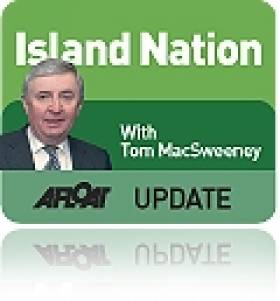Displaying items by tag: Ric Morris
Adult Sailing Needs a Lift - Ric Morris
#sailing – The keenest sailors are coming out of youth classes looking around and thinking that they have left the best sailing of their life behind them. Why has adult sailing failed to grasp the issue of creating a well-structured and genuinely competitive national level of competition writes Dublin based Sportboat sailor Ric Morris.
Tom MacSweeney asks in his latest Island Nation, what does the ISA do for me as a club member? The short answer is that as an ISA member via a club, the ISA by and large acts to protect the interests of your club. The degree to which this is the case is profoundly demonstrated by the recent vitriol over any ISA activity that is not directly club related , be that the delivery of a high performance program based on delivering success rather than a pathway to the games for club members or by including boats with a motor with in their remit
I have huge respect for Roger Bannon but I found some of his recent arguments a little confusing. He seems to believe that the current ISA pathway does not develop a lifelong love of sailing, focusing too much on performance, while simultaneously suggesting that the same programme does not include enough racing at a young enough age.
There seems to be a lot of finger wagging about the junior program and pathway. Some of it may be accurate. I've certainly come across many parents who are looking for a relatively wholesome activity to keep their child occupied through their teenage years rather than a lifelong sport to share with them. The way the top end of the program creates instructors rather than sailors is certainly a concern too, although the focus on creating instructors is largely driven by demand from parents looking at J1 or gap year opportunities rather than ISA policy.
One of the countries most qualified instructors used to rent a room off me. While he was camped in my living room each day he did a huge amount of work on the youth sailing program at Howth, predominantly using the ISA programs and pathways. It was clear to me from this -- and from the guidance given to parents I've heard repeated given -- that the focus of the training currently used to introduce children to sailing is entirely based on developing confidence with and a general interest in being on the water. The pursuit of competitive racing at that age is driven by the interest shown by the child .... or the parent ... but to be fair not on creating fodder for existing classes. There is nothing with in the early stages of the ISAs sail training its self that pushes kids into something they are not enjoying and out of the sport.
Over all slamming the ISA's youth training programme is wide of the mark. There are complaints that an out dated wooden double handed dinghy junior class has been over looked. Perhaps it's believed that an out dated wooden double handed junior dinghy class is the ideal route for producing dumbed down race focused sailors with a low enough expectation that they will want to race in old out dated double handed senior dinghy classes? A clear case of cart before horse.
Is this issue being raised through genuine concern or though vested interest by the newly instated committees of a couple of the more active and established dinghy classes; with what's turning into a genuinely successful high performance programme and one of our most successful Olympians being treated as a political football and stalking horse?
Given that the point that the funding for the high performance program is independent and none transferable is repeatedly ignored you have to wonder. You have to wonder where the criticism of the hard work being done to introduce sailing as part of school activity is coming from too. Is this activity diverting people away from other forms of sailing? Or is it opening up the sport of sailing to a wider group of people in a format that can support a sailor without requiring investment in equipment and research shows is more successful keeping tweenages in the sport of sailing, in all its forms? More the latter than the former in my view. This isn't a zero sum game.
By the way before anyone tells me that the Mirror is no longer an out dated wooden double handed junior class, note that these are the boats it is proposed should be resurrected from hedgerows and garages and that a modern GRP Mirror tweeked within the tolerances allowed by the rules is around 20% more expensive than an RS Feva. A cheap way to access the sport it is not.
The amount of effort being expended is admirable, It's focus is not.
The real questions are:
Why isn't adult sailing offering the kind of sailing that the sailors who are coming out of the junior and youth programmes can access and want to do? The question was asked by someone of the relevant age in the recent debate and completely ignored.
Why has adult sailing failed to grasp the issue of creating a well-structured and genuinely competitive national level of competition? Why are the keenest sailors coming out of the youth classes etc, looking around and thinking that they have left the best sailing of their life behind them or felling they they should dip into specific events in order to get it?
When the formula is so simple (club fleets make classes, club captains make club fleets) why is nearly every class in Ireland a single club class?
And perhaps most importantly, why has adult sailing so badly failed to address the shift in free leisure time from men to women?
I doubt the answers lies with the status quo or in the past.
If dinghy sailing was to get its wish and get an ISA board member, if they were genuine about it the addressing the kind of questions being asked of the ISA what would they do?
They'd start by abandoning the "All Ireland whatever it's called this year championship" and set up an open entry national sailing championships covering a limited number of disciplines each using dictated equipment. They'd then actively prevent all the other classes from referring to their national champs as such and put what effort they could muster into encouraging clubs to set up fleets of those classes.
Here's a suggestion of what those classes would be: 4 dinghy disciplines (single handed, double light weight, double heavy weight, high performance), 1 OD keelboat discipline, and the ICRA classes. Plus may be team racing. No more.
If not the above then do the dinghy class associations really deserve an ISA board member in order to help them with their admin?
Irish Match Racing Gets Recognition it Deserves
Match Racing has been given full approval by the national sailing association. I reported a few weeks ago that Match Racing Ireland, which organises the racing, had made application to the Irish Sailing Association. This has been approved.
"We are now a recognised Category 3 organisation within the ISA and hope this will mean we can send a representative to the All-Ireland championships, dependent on an invitation to us. Being recognised as a formal body is important for funding or when individual teams need support at international events," Ric Morris of Match Racing Ireland told me. "Bringing people through from college sailing is something we are very interested in and we are at the moment targeting the 2012 World University Match Racing Championships in France."
That may mean having to get hold of a couple of J24s, the boats used for that event. Match racing here has so far been concentrated in the ISA J80 fleet. Ric said he was "confident match racing will continue to flourish. The question will be the scope of it. Howth, Lough Derg and Dun Laoghaire clubs have confirmed they will run match racing next year."
Next month Kinsale will be the location for two match racing events - the ISA Women's Match Race Championship on October 9 and 10 followed by the Open Match Racing Championships from October 22-25.
Dragons Are Still Alive
The English are known for preferring that the rest of the world would speak their language. That attitude resulted in a Norwegian-designed yacht being called a Dragon.
Sailed by a helm and crew of two, it was designed by Norwegian Olympic sailor, Johan Anker, in 1929 with two berths for cruising in his home waters. The boat became so popular that, within ten years, it had spread all over Europe and become established in the top echelons of yacht racing. The Clyde Yacht Association presented the Gold Cup to the class in 1937.

Dragons competing off Kinsale. Photo: Bob Bateman. Gallery HERE.
During negotiations for the official recognition of the boat by the international sailing federation, a translation of Anker's name into 'Draggen' was rejected by the English yachting association which found 'Dragon' easier. The name was applied to the boat. Johan Anker was killed in World War Two. After the war his family waived design royalties to allow English yards build the boats, "as a token of appreciation for British support of Norway" when it was invaded by the Germans. That led to an increase in its popularity.
Dragons raced their South Coast Championship off Kinsale with ranking points to be won for the World and European Championships. Local club sailors were hoping to end class domination by Dun Laoghaire, but just fell short of their target.
Andrew Craig sailing Chimaera took the South Coast title back to the Royal St.George in Dun Laoghaire, while his clubmate Martin Byrne in Jaguar was second. Cameron Good, Henry Kingston and Simon Furney, a long-established Kinsale team sailed Little Fella, to third overall, with club colleague James Mathews helming Diva, crewed by Rick and Rob Johnson in fourth.
I have heard the Dragons described as "old worldly" but the class is alive and well to judge from the racing in plenty of breeze off Kinsale, where the Dragon Gold Cup, a world event, will be held in 2012. Kinsale Yacht Club will also host the national championships next year.
KYC is and will be, a busy place.
• This article is reprinted by permission of the CORK EVENING ECHO in which Tom MacSweeney writes maritime columns twice weekly. Evening Echo website: www.eecho.ie
Sharkbait Takes Early Lead at SB3 Nationals
Ben Duncan, Brian Moran and Ric Morris on Sharkbait have eased into an early lead after day 1 of the Investwise SB3 Ireland National Championships in Howth. Sailing on their home waters the Howth Yacht Club team took home 2 bullets and a 6th to lead over night by 4 points from Stefan Hyde, Jerry Dowling and Jimmy Dowling. Brian Reilly, Sam Hunt and Conor Clancey lie 3rd, with Sean Craig, Stepen Boyle and Alan Green in fourth and McCready Gill Racing Team in 5th.
Photos by Gareth Craig on the gallery HERE
































































